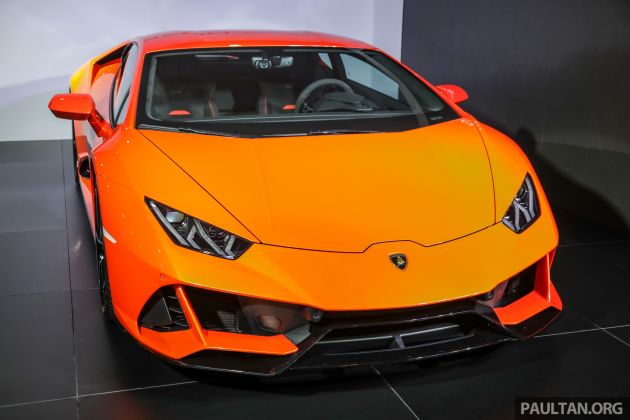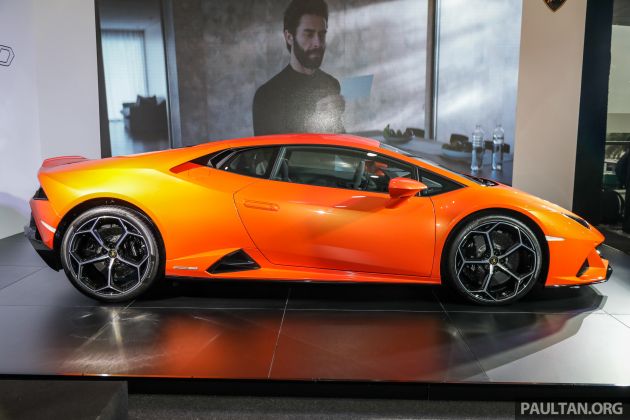Unveiled in January, the Lamborghini Huracan Evo made its Malaysian debut over the weekend at Sepang. Deliveries will only begin later this year, with the first examples expected to arrive sometime in the fourth quarter.
The facelift features the 5.2 litre direct-injected, naturally-aspirated V10 as seen in the outgoing Performante. Output numbers are 640 hp at 8,000 rpm and 600 Nm of torque at 6,500 rpm, the power being applied to all four wheels via a seven-speed dual-clutch transmission.
Performance numbers include a 0-100 km/h time of 2.9 seconds, identical to the Performance despite carrying 40 kg extra in dry weight, at 1,422 kg. Moving on, it accomplishes the 0-200 km/h in 9.0 seconds, and has a top speed of over 325 km/h.
The refresh introduces a number of exterior changes, including a new front bumper and Y-shaped air intakes, along with a splitter and integrated wing. New side air intakes also make their way on.
At the back, the Evo features a new sports exhaust system, with its twin outlets positioned high above the rear bumper. There’s no Aerodinamica Lamborghini Attiva (ALA) active aero system to be found, but a new integrated, slotted spoiler helps enhance air flow.
Elsewhere, the underbody has been reworked to maximise aerodynamic efficiency, resulting in the new car having more than five times the downforce and aero efficiency of the original Huracan.
Mechanically, there’s a new rear-wheel steering, along with a torque vectoring system, but the automaker says the biggest improvement in performance has come with the inclusion of the Lamborghini Dinamica Veicolo Integrata (LDVI), a central processing unit that not only integrates and controls all of the car’s electronics, but also predicts the driver’s next move and needs, adjusting the car’s delivery to suit.
Here, the Lamborghini Piattaforma Inerziale (LPI) as seen on the Performance has been enhanced into a version 2.0 form. Essentially, the LPI is a set of accelerometers and gyroscope sensors placed at the car’s centre of gravity, and the update brings about more precise real-time measurements of the car’s dynamic attitude in lateral, longitudinal and vertical acceleration, as well as roll, pitch and yaw rate.
Elsewhere, the magneto rheological dampers in the active suspension have also been upgraded and work in tandem with LPI, and a new, more advanced traction control system, together with the enhanced all-wheel drive system and torque vectoring, allows traction to be directed to a single wheel as required. Also on is Lamborghini Dynamic Steering (LDS), which enhances low-speed agility and high-speed cornering and braking stability.
It’s all good enough to turn the Huracan into a super agile and responsive vehicle with unparalleled level of control, the car now being able to recognise the driver’s intentions in real time through steering, brake and throttle inputs, along with the selected gear and the driving mode (Strada, Sport or Corsa) chosen.
The display car at Sepang was a left-hand drive example dressed in the automaker’s new four-layer Arancio Xanto exterior colour and 20-inch Aesir wheels. Buyers can of course choose to customise the car with new black or body-coloured Style Pack options, as well as from elements available in the Ad Personam programme.
Inside, the palette of colour and trim options has been expanded with a dedicated Evo trim in an Alcantara and leather material mix, with Arancio Dryope highlights to match the new exterior shade.
There’s also a new 8.4-inch capacitive touchscreen, which not only incorporates connected navigation and entertainment, Apple CarPlay connectivity and voice commands, but also multi-finger gesture control, seat and climate control adjustment as well as LDVI system status. Available as an option is a dual-camera telemetry system and integrated high-capacity hard disk.
Pricing for the Lamborghini Huracan Evo hasn’t been finalised, but according to Lamborghini Kuala Lumpur COO Marcus Chye, the base price excluding taxes should be roughly about the same as the outgoing car, at around RM1.15 million.
Source: Read Full Article











